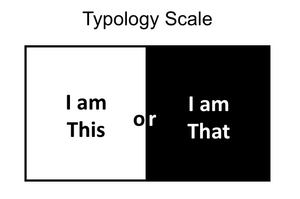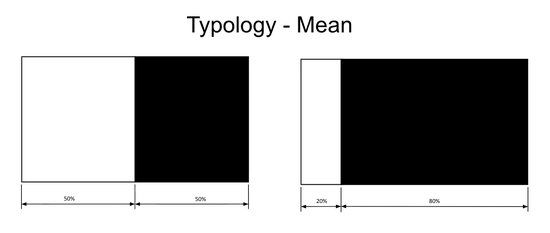Scales and Intensity: Difference between revisions
m (→Typology Scale) |
m (→Typology Scale) |
||
| Line 27: | Line 27: | ||
Multiple typologies, also referred to by some systems as themes or strengths, use the same shortcuts as a standard typology, and the challenges are the same as with decile scales and value-based scales when comparing scores, for representing how intense behavior may be expressed and described. The illustration below on the left represents a system where types are ranked, and on the right, another system where people are assigned to a type among four. | Multiple typologies, also referred to by some systems as themes or strengths, use the same shortcuts as a standard typology, and the challenges are the same as with decile scales and value-based scales when comparing scores, for representing how intense behavior may be expressed and described. The illustration below on the left represents a system where types are ranked, and on the right, another system where people are assigned to a type among four. | ||
[[File:Multiple Typology Scales.png|center| | [[File:Multiple Typology Scales.png|center|450px]] | ||
Typologies are oversimplifications that offer shortcuts to categorize people. They are easy to understand, but also lead to inaccurate assumptions and to apply negative stereotyping, hiding important nuances of the dimension being measured. They cannot account for the adaptation and development of the behaviors being described. | Typologies are oversimplifications that offer shortcuts to categorize people. They are easy to understand, but also lead to inaccurate assumptions and to apply negative stereotyping, hiding important nuances of the dimension being measured. They cannot account for the adaptation and development of the behaviors being described. | ||
Revision as of 04:49, 14 October 2025
Normativity
With assessment techniques, normativity refers to the ability of the technique to compare an individual's results to a larger population. Since the word normative also implies in sociology and organizations specific rules to follow, it’s important to note that “normativity” in assessment only pertains to how data is normalized, eventually using a normal Gaussian distribution or quantile scales, to allow meaningful understanding of a score and comparisons with other scores.
Normative assessments usually compare people based on gender, culture, age, or job type. For example, in medicine or with clinical assessments, different norms are used for different age groups or genders. Scales for adolescents differ from those for adults and seniors, which helps to improve diagnoses and prescriptions. While this approach is necessary in medicine and clinical settings, it is not suitable for work applications, creating inappropriate comparisons and bias.
Ipastivity
With assessment techniques, ipsativity refers to the comparisons made between two or more dimensions being measured, rather than comparing them to a larger group, such as what normative approaches do. Ipsativity is intrapersonal as it deals with various attributes of a single individual. The peculiar name “Ipsative” comes from the Latin word ipse, which means "of the self." Ipsative assessments typically ask questions requiring forced choices, such as True/False, Yes/No, or by ranking the attributes presented in order. With ipsative measures, we are dealing with "within-person" comparisons, rather than comparisons with other people, as is the case with normative measures. The results of the same person’s various attributes are compared with each other at one point in time, or an attribute’s value is compared with other values at different times.
Decile Scale
A decile scale is a type of scale that separates data into ten equal groups. A person's decile rank indicates which of these ten groups their score falls into, providing an understanding of the person’s score relative to a representative sample of a larger group (also called a normative group in statistics).
Percentile scales provide an even more precise granular view by dividing the scores into 100 equal groups. Decile or percentile scales help understand the intensity of an individual's score, including identifying if the score is at the bottom or top, compared to the larger group. However, as the figures below indicate, scores can be heavily skewed towards the lower or upper end. This will mislead the interpretations of the score’s distribution, particularly when comparing it with other scores, as often happens with social behavior dimensions.
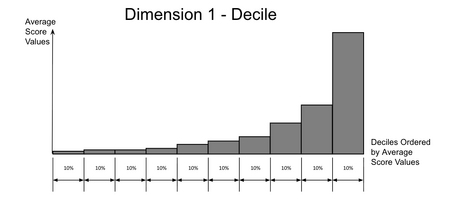
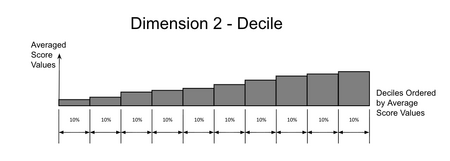
Value-Based Scale
Scores may be ordered based on their values from low to high, between 0 and 10, as often happens with the measurement of personality dimensions. The value distribution may look like the one below, with a different number of people for each group of values. Like Decile scales, value-based scales mislead the understanding of a score's intensity. Values are never evenly distributed. Comparing scores, as it often happens with social behavior dimensions, misleads the analysis even further.
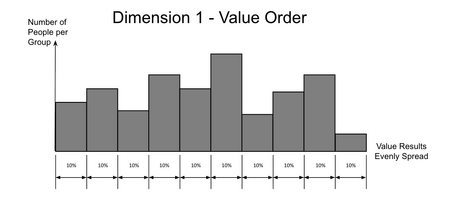

Typology Scale
In a standard typology, the scale is very simple: you either have it or you don't. “You are this” with the characteristics associated with the type, without any nuances that may fit your particular situation. Standard types come on their own, as with systems measuring if one is being a trailblazer, warrior, leader, activator, helper, reformer, enthusiast, peacemaker, arranger, relator, woo, maximizer, etc., or not. Types are often presented as a dichotomy, such as “I am this” or “I am that”, an introvert or an extrovert, rich or poor, white or black, without any shades of gray, like in the illustration below. The two parts of the dichotomy are mutually exclusive, in a sharp contrast with one another.
With social behaviors, a dichotomy’s mean can vary, as the illustration below represents, including more or fewer people in a type, depending on whether the outcome needs to be balanced or unbalanced, but not necessarily reflecting one’s reality. As for the decile and value-based scales, one cannot know how multiple scores combine, but with even less accuracy.
Multiple typologies, also referred to by some systems as themes or strengths, use the same shortcuts as a standard typology, and the challenges are the same as with decile scales and value-based scales when comparing scores, for representing how intense behavior may be expressed and described. The illustration below on the left represents a system where types are ranked, and on the right, another system where people are assigned to a type among four.
Typologies are oversimplifications that offer shortcuts to categorize people. They are easy to understand, but also lead to inaccurate assumptions and to apply negative stereotyping, hiding important nuances of the dimension being measured. They cannot account for the adaptation and development of the behaviors being described.
Standard Scale
A standard scale converts raw scores into a scale with a mean and standard deviation. A standard deviation is a deviation that is standard: it is the average of all deviations from the mean of the normal sample. With this scale, a score can better account for a dimension’s intensity. It also helps compare scores, which is needed when analyzing social behavior dimensions that influence each other. The normal distribution is often (but not exclusively) represented by a Gaussian distribution, as is shown below.
GRI Scale
The GRI scales combine the benefits of normative distributions and ipsativity, which helps analyze how the different factors relate to each other, and to the larger population. This capability comes partly because of the survey's free-choice format, allowing respondents to select as many or as few adjectives as they like when answering the two questions. After scoring, the answers are compared to a larger population and ipsatized.
As we know from research, notably that conducted with analyzing lexicons in different cultures, and as we have also evidenced at GRI, some behavioral factors are universal. Normative measures are based on a sample that’s representative of the larger population covering different genders, ages, political and religious beliefs, and cultural backgrounds. The mean, or any other point on the scale, can serve as a reference for comparing measures, but the mean is neutral and practical, which is why we use it at GRI. The standard deviation scale measures the distance from the mean as a reference point. How much the score deviates from the mean in standard deviations provides a more accurate account of its intensity and the predictability of its occurrence than other types of scales can.
Having a better account of a score’s intensity is important for understanding the efforts it takes to adapt a behavior, planning personal development, but also for making meaningful comparisons with what’s required in a job and between people.

